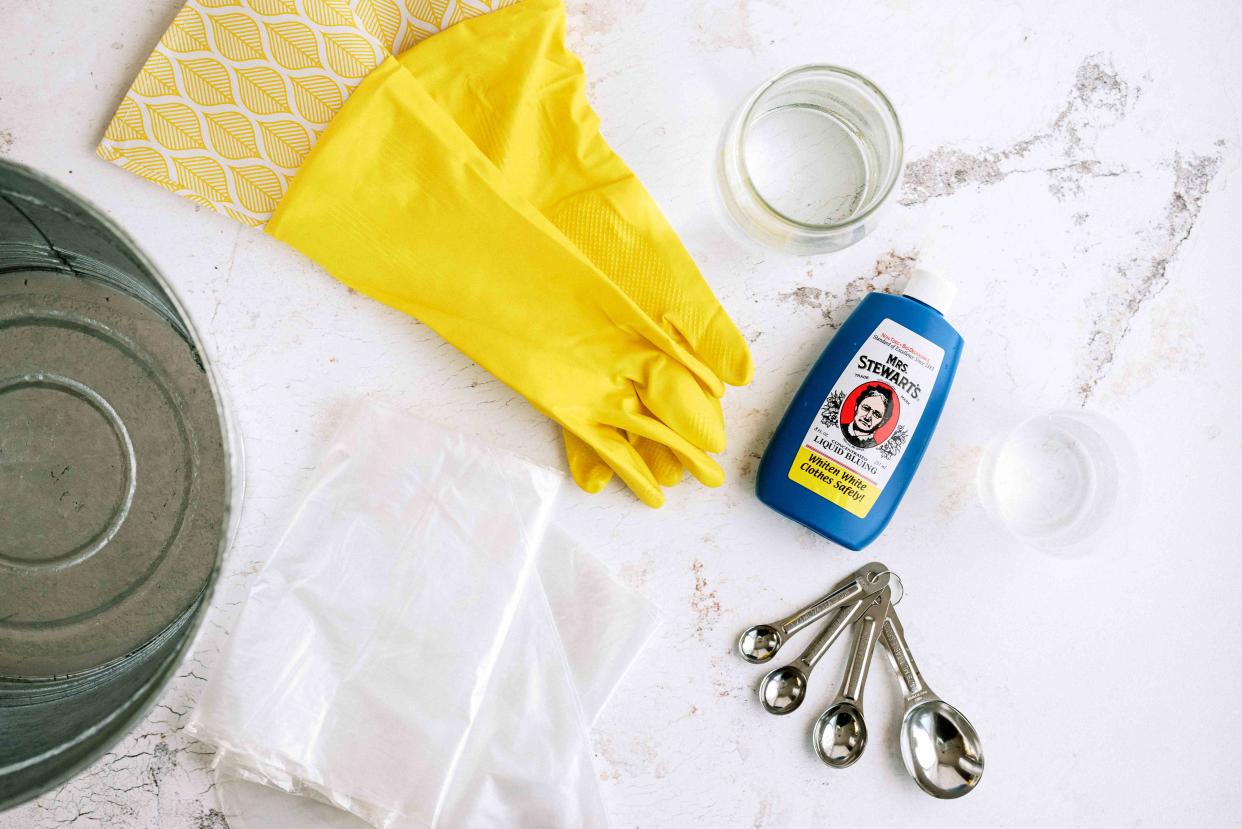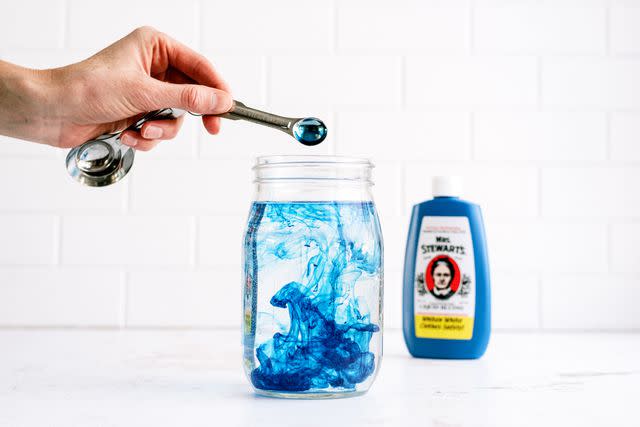Laundry Bluing: What It Is & How to Use It

The Spruce / Michele Lee
Reviewed by Brandon PleshekFact checked by Cherisse Harris
Bluing products improve the brightness of white fabrics by adding a blue pigment that counteracts the natural yellowing that occurs during regular laundering. These bluing products come in both powdered and liquid forms. The eye perceives the nearly undetectable amount of blue and sees the fabric as whiter. Commercial bluing products are highly concentrated and must be diluted before use to prevent permanent staining and streaking.
What Is Laundry Bluing?
In laundry bluing, a product adds a trace amount of blue dye to white fabric during laundering to improve its appearance. Bluing products in higher concentrations can darken jeans and other blue fabrics.
How Do Bluing Products Work?
Liquid bluing is a colloidal suspension of a very fine blue iron powder and water. Other ingredients include a pH balancer and a biocide to prevent the buildup of algae and bacteria. You can also purchase bluing powder.
Mrs. Stewart's Liquid Bluing is a leading brand in the United States; other brands include Bluette and Reckitt's Crown Blue.
Learn how bluing works, how to use it in different types of washers, be able to darken up those jeans you want to a darker blue and see how you can remove bluing stains from your clothing.

The Spruce / Michele Lee
How to Use Laundry Bluing in a Top-Load Washer
Manufacturers use bluing in the finishing process of white goods, but unfortunately, the bluing wears off after repeated washings. The good news is you can add it back by using off-the-shelf liquid bluing. Here's how:
Always dilute bluing (it is highly concentrated) in cold water before adding to any type of washer. Never pour it directly into the machine because it can permanently stain fabrics. To whiten whites in a standard or top-load HE washer in the wash cycle, stir 1/4 teaspoon liquid bluing into one quart of water. Use a glass jar to prevent staining plastic containers. Then add the solution to the wash water.
If adding bluing only to the rinse cycle, use 1/8 teaspoon dissolved in a quart of water. Never use an automatic dispenser for bluing in a top load washer for either the wash or rinse cycle addition because it will stain the dispenser.
Bluing can be used with detergent but should not be used with chlorine bleach, fabric softener, or any other laundry product. There will be no hazardous fumes, but the other products will cause spotting or staining if used with bluing.

The Spruce / Michele Lee
How to Use Laundry Bluing in a Front-Load Washer
For use in a front load washer, use the same amounts of bluing as directed above. If the dispensing drawers on your washer remain unlocked during the cycle, dilute the bluing in one to two quarts of water and add through the dispenser directly into the cycle after it has already filled with water.
If the drawers on your front load washer lock as the cycle begins, dilute the bluing as directed on the bottle and then put as much diluted bluing as will fit into the largest available drawer.
How to Use Laundry Bluing to Darken Jeans
For blue jeans, more bluing can be used. You can use up to one teaspoon per quart of water depending upon how dark you want your jeans to be. Follow the directions for your washer or use a porcelain sink or metal bucket for the process. The bluing will stain plastic containers and fiberglass sinks permanently.

The Spruce / Michele Lee
How to Remove Bluing Stains
We all have a tendency to think if a little bit does a good job, a little more will be even better. That may work for some things, but not for bluing. If you've gotten a little heavy-handed or skipped some steps in using bluing correctly, here's how to remove the bluing stains from washable clothes:
You need a non-metal container that can be covered tightly (a five-gallon bucket with a good, tight lid or a plastic bag with a twist tie).
Place the stained clothes in the container.
Mix a solution of 1/2 cup household ammonia to one-quart cold water. Make enough solution to completely submerge the stained clothing.
Make the container as airtight as possible to keep the fumes in. Ammonia evaporates very quickly, and ammonia is the only substance that will remove the excess bluing.
Soak for 24 hours.
If the stain is not gone in 24 hours, mix a fresh ammonia solution and repeat the process.
Finally, wash the clothing on a regular wash cycle with detergent only.
Warning
Never mix ammonia with chlorine bleach. The mixing of ammonia and chlorine bleach causes toxic and dangerous fumes. Bleach will also set the bluing stains permanently.
If you have already attempted to remove the excess bluing with chlorine bleach, use a solution of one cup household ammonia to one quart of cold water and soak, covered tightly for 48-72 hours. You may need to perform this procedure two to three times, washing with detergent following each process.

The Spruce / Michele Lee
Frequently Asked Questions
Is laundry bluing still used?
Yes, laundry bluing is still used. It can be used to improve the appearance of white fabrics and to darken jeans.
Does liquid bluing really work?
Yes, liquid bluing does work when applied properly. There are different methods depending on your laundry and laundry machine.
What is laundry bluing made of?
Laundry bluing is made of a colloid of blue iron salt, giving it its blue hue.
Where do you put bluing in a washing machine?
If you have a top-load washing machine, add a diluted solution of bluing into the wash water. For front-load machines, add to the wash water if the machine will allow, or if the door locks once it starts, follow the instructions on the bottle.
Is laundry bluing safe for colored clothes?
Yes, laundry bluing is safe to use on colored clothes as well, and some suggest that it makes their colors brighter.
Read the original article on The Spruce.
